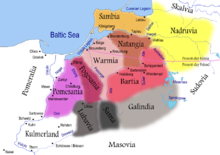
Nadrovia (or Nadruvia ) ( Prussian. Nadrawa, Nadrāuwa [1] , German. Nadrauen , lit. Nadruva , Polish. Nadrowia ) is a historical region of Europe . Nowadays it is almost completely located in Russia , only a small southern part belongs to Poland .
Content
Geographical Description
Currently, most of Nadrovia is part of the Kaliningrad region ( Gusevsky , Ozersky , Chernyakhovsky urban districts, as well as parts of Pravdinsky , Guards , Polessky , Nesterovsky , Slavsky , Nemansky and Krasnoznamensky ).
Nadrovia is occupied by the Pregolya river basin: in the west of the tributary of the Pregoli Nekhni / the arm of the Pregolya Dima (separating Nadrovia from Sambia ), to the watershed of the Pregol with the Biebrza River and the upper course of Shesupy , which separate it from other historical regions of Europe: from the south - from Bartia and Galindia , and from the east - from Sudovia .
In the north of Nadrovia it borders with Skalovia , and in the west - with Nattangia .
History
Name Origin
The name comes from the Prussian tribe of nadrov , which some linguists like Vytautas Mazhulis , Zigmas Zinkevicius refer to the Lithuanians or consider a tribe in the ethnolinguistic concept.
There is no consensus among linguists about the origin of the ethnonym Nadrov.
The Lithuanian linguist Kazimir Buga believed that the name nadravo is a compound of the Prussian words na ( na ) and dravo (tree), which can be literally translated as Polesye . Zinkevicius builds the second part in na-dravo to the hypothetical Indo-European basis of dhreu (stream). In this case, the literary translation will be Porechye . Vilius Peteraitis believes that the word drava is not the name that has survived to this day of one of the tributaries of the Pregol . Finally, there is a folk etymological interpretation of the word Nadrov as a derivative of the personal name Nadro, which belonged to the son of the Prussian leader Videvut .
Prussian period
Nadrovia was one of the eleven regions (Gaue) that Prussia shared before the reform of Frederick the Great .
Recent History
It became a part of the USSR after the Great Patriotic War , now the main part of Russia as the legal successor of the USSR, a small southern part - as part of Poland.
Notes
Literature
- Gerullis, Georg: Old Prussian names, Berlin, Leipzig 1922
- Peterhaitis, Vilius: Little Lithuania and Twankst (Lithuania Little and Thunst) Vilnius 1992
- Mortensen, H. u. G .: Wildlife in East Prussia, its condition around 1400 and its former settlement, Leipzig 1938
- Tettau, v.: Folk Tales of East Prussia, Littauens and West Prussia, Berlin 1837
- Father, Johann Severin: Mithridates or general linguistics with his father Unters als Sprahprobe, Berlin 1809